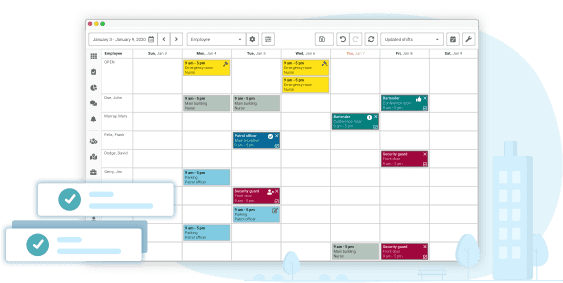Here at Celayix, the majority of our customers operate with mobile workforces. We operate in home healthcare, security, events, and other industries dealing with mobile workers. Their employees are out in the field, on client sites, and away from any centralized workplace. The global mobile workforce has seen exponential growth in recent years, surpassing even IBM‘s earlier forecast of reaching 1.87 billion workers by 2022. This surge in mobile workforce numbers, which has been further accelerated by recent global events, has significantly heightened the demand for effective mobile workforce management strategies.
As a testament to this expanding need, the Mobile Workforce Management market was valued at USD 4.5 billion in 2022 and is projected to continue its impressive growth, with industry experts anticipating it to reach USD 14.17 billion by 2032. This surge is fueled by the increased demand for mobile applications and the pursuit of workforce optimization, driving a remarkable compound annual growth rate of 13.60% during the forecast period.
What is Mobile Workforce Management?

Mobile workforce management (MWFM) refers to the tools, techniques, and resources used to ensure a mobile workforce’s maximum efficiency and productivity. It includes anything that might support a mobile workforce in effectively completing their duty. Essentially, it aligns with the general goals of workforce management. These goals are to ensure maximum productivity, efficiency, and profitability of a workforce. Here at Celayix, we like to summarise it as having the right people at the right place at the right time.
With the right tools and resources, you can easily schedule, monitor, track, and report on your remote workforce as they carry out their work. These tools and resources are generally seen as an investment for organizations. Thankfully, there are tangible benefits to ensuring you can effectively manage your remote teams.
The Benefits of Mobile Workforce Management
Consider the difficulties that come with managing a deskless mobile worker. Before we even dive into the benefits of mobile workforce management, it’s easy to imagine how anything that can streamline that complex process would greatly benefit managers. Most organizations we work with here at Celayix have seen some, if not all, of the benefits below.
Increased Productivity
Mobile workforce management tools generally provide support to both the remote employees and those who manage them. McKinsey estimates that these kinds of solutions increase the number of jobs a business can execute by 20-30% per full-time employee daily. Providing your workers who work remotely with the resources they need when they actually need them allows them to focus on getting their job done. Effective employee scheduling and dispatch, paired with professional communication tools, leads to fewer inefficiencies and less downtime.
Improved Insight for Management
Perhaps one of the most difficult areas of managing a team when you’re not physically with them is simply knowing where your workers are. Managers want to be able to account for all of their employees without having to be physically present on-site. This is because managers are often responsible for multiple locations/client sites. Software that has the capability to manage your remote teams provides key information and data to managers from anywhere. Managers want everything in one central place: time and attendance data, incident reports, or task completion.
Improved Client Satisfaction

Businesses in the industries mentioned above and any others that handle mobile workers understand the importance of client satisfaction. Poor communication, late employee check-ins, or unreported incidents impact client satisfaction, right? However, with effective mobile workforce management, employees and management can access key information that can enhance client satisfaction and mitigate the risk of a negative experience.
Do You Have The Right Features for Your Remote Team?
One of the best ways to achieve all of the benefits above is to ensure that your workforce management software has mobile capabilities built into it. Managing your remote teams can be difficult and create more issues without the right tools and resources. However, with the right tools in your back pocket, you will have tonnes more functionality and features that will ultimately help automate your processes and improve operational performance.
One of the first hurdles of managing a mobile workforce, especially in today’s dynamic gig economy, is monitoring and sustaining employee productivity. Managers cannot guarantee the completion status of tasks or assignments without actively communicating vital tasks and other assignments in person. They also may not know who completed what work and when. Managers need this information to enhance operations and ensure the timely completion of all work continuously.
Here are some mobile features you should be looking for in your software:

- Employee schedule creation automation
- Labour forecasting to avoid over/understaffing
- GPS Geofencing to track employee check-in/out times on site
- Live map view to show which employees are where
- Instant communication tools so supervisors can contact their teams from anywhere
- Shift reminders and notifications for mobile workers.
- Shift tasks and field reporting to help with task management and tracking
- Instant alerts for late or no-shows
- Find Replacement to help immediately dispatch replacement employees to client sites.
With these features, you will have peace of mind knowing your teams are showing up to work on time and are where they are!
Tips for Managing Your Mobile Staff
Create efficient, well-optimized employee schedules.
One of the best ways of ensuring you have the right people in the right place at the right time is by scheduling them there. While this sounds incredibly simple, we can assure you that it is very difficult. There are many moving parts to any employee schedule, let alone an employee schedule handling many workers across multiple sites. Celayix MWFM software uses both a rules-based scheduling engine and artificial intelligence to find the best-fit employee for all of your shifts.

The rules-based engine helps schedulers ensure that no unnecessary overtime is scheduled and that other critical rules are obeyed. These often include rules on seniority, hours worked, or legal requirements. Artificial intelligence, however, looks at historical data and can match employees to sites they are commonly scheduled, clients they regularly work with, or days they usually work. These well-optimized employee schedules provide the best workforce quality to your clients at all times, where possible. Therefore, you maintain your existing happy clients, making it easier to attract new ones.
Managing Productivity
One of the first hurdles of managing a mobile workforce is monitoring and sustaining employee productivity. Without being present to communicate vital tasks and other assignments, managers cannot guarantee what tasks are completed or not. They also may not know who completed what work and when. All of this is important information for managers to continuously improve operations and ensure all work is completed on time.
Shift tasks and field reporting are one simple way to overcome this hurdle. If you currently use some form of workforce management software, it might have this functionality built-in. If not, it can, of course, be managed with other tools. Basically, it allows managers to assign specific tasks to certain shifts and send them directly to employees through a mobile app. Assuming all of your employees own a smartphone, they can track and manage all of their tasks at the touch of a button. Not only can employees see and manage these tasks, but management can see them in real time as they are updated. This helps ensure that everything gets done when needed and allows management to stay in the loop.
Automate Time and Attendance Processes
Time and attendance processes are key elements of mobile workforce management. They help track and validate where employees are and when they are there. Managers use this key data in other important business functions, such as payroll or client billing. Time and attendance tracking can be difficult and time-consuming without the right software or technology. When it comes to managing a remote team, it is crucial to ensure that your employees are on-site on time and remain there to complete their tasks. Celayix software provides an advanced employee mobile app and supervisor platform so you can keep track of this.
The mobile app provides an accurate and efficient employee check-in/out method using geofencing. Then, the data is reflected on the supervisor platform, alerting them that employees are on-site, on time, or otherwise. Because of this, supervisors do not have to filter through timesheets. Moreover, there is a decreased likelihood of time fraud or theft, which is critical for effective mobile workforce management. Celayix can then pass the collected time and attendance data over to payroll/billing through integrations. As a result, organizations see less human error and improved accuracy, which leads to cost savings.
Celayix has been helping organizations manage their mobile workforces for over 20 years. Our team of solution advisors is on hand to answer any questions you might have on how Celayix could help you today. Feel free to request a free custom live demo, or contact us here today.




